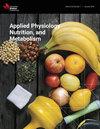孕期 GLP-1 反应:不同孕期的变化以及与食欲感觉和通常能量摄入量的关联
IF 2
4区 医学
Q3 NUTRITION & DIETETICS
引用次数: 0
摘要
应用生理学、营养学和新陈代谢》(Applied Physiology, Nutrition, and Metabolism, Ahead of Print)。 要了解孕期食物摄入的激素调节及其与能量摄入的关系,还需要进一步的研究。该研究的目的是:(i) 比较不同孕期血浆胰高血糖素样肽-1(GLP-1)的餐后反应;(ii) 比较不同孕期的餐后食欲感觉;(iii) 研究特定孕期 GLP-1 水平、食欲感觉和通常能量摄入之间的关联。在每个孕期,参与者(n = 26)在禁食 12 小时后食用标准测试餐。采用酶联免疫吸附法测定空腹和餐后 30、60、120 和 180 分钟时的血浆 GLP-1 水平。在空腹和餐后 15、30、45、60、90、120、150 和 180 分钟时完成评估食欲感觉的视觉模拟量表。每个孕期的平均能量摄入量是通过三次基于网络的 24 小时膳食回顾来评估的。与怀孕前三个月相比,怀孕后三个月(p = 0.004)和怀孕后三个月(p < 0.001)的餐后 GLP-1 反应较低。与怀孕前三个月相比,怀孕后三个月的餐后进食欲望、饥饿感和预期食物消耗量更大(均为 p < 0.04)。在妊娠第二个三个月,空腹 GLP-1 与空腹食欲感觉(除饱腹感外)呈负相关(均为 p < 0.02)。餐后 0 至 30 分钟内,GLP-1 与饱腹感之间的曲线下面积递增在妊娠中期(p = 0.01)和妊娠晚期(p = 0.03)有明显关联。没有观察到空腹或餐后 GLP-1 与通常能量摄入量之间的关联。总体而言,不同孕期的 GLP-1 和食欲感觉反应存在显著差异,但 GLP-1、食欲感觉和通常能量摄入量之间几乎没有关联。本文章由计算机程序翻译,如有差异,请以英文原文为准。
GLP-1 response during pregnancy: variations between trimesters and associations with appetite sensations and usual energy intake
Applied Physiology, Nutrition, and Metabolism, Ahead of Print.
Further research is required to understand hormonal regulation of food intake during pregnancy and its association with energy intake. The objectives are to (i) compare postprandial responses of plasma glucagon-like peptide-1 (GLP-1) between trimesters, (ii) compare postprandial appetite sensations between trimesters, and (iii) examine trimester-specific associations between GLP-1 levels, appetite sensations, and usual energy intake. At each trimester, participants (n = 26) consumed a standard test meal following a 12 h fast. Plasma GLP-1 levels were measured by enzyme-linked immunosorbent assay method at fasting and at 30, 60, 120, and 180 min postprandial. A visual analogue scale assessing appetite sensations was completed at fasting and at 15, 30, 45, 60, 90, 120, 150, and 180 min postprandial. Mean energy intake was assessed using three web-based 24 h dietary recalls at each trimester. Lower postprandial GLP-1 responses were observed in the 2nd (p = 0.004) and 3rd trimesters (p < 0.001) compared to the 1st trimester. Greater postprandial sensations of desire to eat, hunger, and prospective food consumption were noted in the 3rd trimester compared to the 1st trimester (p < 0.04, for all). Fasting GLP-1 was negatively associated with fasting appetite sensations (except fullness) at the 2nd trimester (p < 0.02, for all). Postprandially, significant associations were observed for incremental areas under the curve from 0 to 30 min between GLP-1 and fullness at the 2nd (p = 0.01) and 3rd trimesters (p = 0.03). No associations between fasting or postprandial GLP-1 and usual energy intake were observed. Overall, GLP-1 and appetite sensation responses significantly differ between trimesters, but few associations were observed between GLP-1, appetite sensations, and usual energy intake.
Further research is required to understand hormonal regulation of food intake during pregnancy and its association with energy intake. The objectives are to (i) compare postprandial responses of plasma glucagon-like peptide-1 (GLP-1) between trimesters, (ii) compare postprandial appetite sensations between trimesters, and (iii) examine trimester-specific associations between GLP-1 levels, appetite sensations, and usual energy intake. At each trimester, participants (n = 26) consumed a standard test meal following a 12 h fast. Plasma GLP-1 levels were measured by enzyme-linked immunosorbent assay method at fasting and at 30, 60, 120, and 180 min postprandial. A visual analogue scale assessing appetite sensations was completed at fasting and at 15, 30, 45, 60, 90, 120, 150, and 180 min postprandial. Mean energy intake was assessed using three web-based 24 h dietary recalls at each trimester. Lower postprandial GLP-1 responses were observed in the 2nd (p = 0.004) and 3rd trimesters (p < 0.001) compared to the 1st trimester. Greater postprandial sensations of desire to eat, hunger, and prospective food consumption were noted in the 3rd trimester compared to the 1st trimester (p < 0.04, for all). Fasting GLP-1 was negatively associated with fasting appetite sensations (except fullness) at the 2nd trimester (p < 0.02, for all). Postprandially, significant associations were observed for incremental areas under the curve from 0 to 30 min between GLP-1 and fullness at the 2nd (p = 0.01) and 3rd trimesters (p = 0.03). No associations between fasting or postprandial GLP-1 and usual energy intake were observed. Overall, GLP-1 and appetite sensation responses significantly differ between trimesters, but few associations were observed between GLP-1, appetite sensations, and usual energy intake.
求助全文
通过发布文献求助,成功后即可免费获取论文全文。
去求助
来源期刊
CiteScore
6.50
自引率
2.90%
发文量
113
审稿时长
4-8 weeks
期刊介绍:
Applied Physiology, Nutrition, and Metabolism publishes original research articles, reviews, and commentaries, focussing on the application of physiology, nutrition, and metabolism to the study of human health, physical activity, and fitness. The published research, reviews, and symposia will be of interest to exercise physiologists, physical fitness and exercise rehabilitation specialists, public health and health care professionals, as well as basic and applied physiologists, nutritionists, and biochemists.

 求助内容:
求助内容: 应助结果提醒方式:
应助结果提醒方式:


